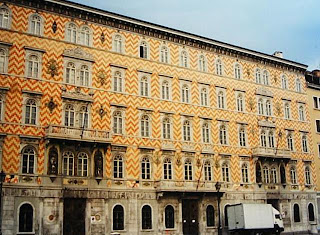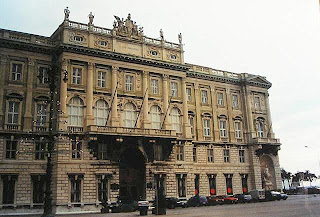In order to stay in the same period of 1997-2000, we descend now from the Northern Europe to Italy. The next posts will be about places I have visited here, in my free time, when I was working in some European projects in Italian universities.
Being for some days in Udine, I wanted to see how Trieste looks like, as this was the dream of many Romanians who fled the country during the communist regime, ilegally entering the former Yugoslavia (many times swimming across the Danube). After a time spent in a camp there, they asked to be sent to Trieste, and from there started their travel to different Western countries, to US or Canada.
I took a late afternoon train to Trieste and spent there some hours. From the railway station I headed to the port, where I knew about a big square, with beautiful buildings, mainly from the 19th century.
After being a Roman settlement (few ruins are still to be seen), Trieste was part of the Austrian-Hungarian monarchy, between 1382-1918. That period left its influence on the architecture of the town.
By chance, I saw a little Christmas market. I think it was the first one I have seen, beside the Viennese ones. It became dark rapidly and from the sea blew a cold wind. I remind all these because it was December, 22, and it was my birthday. I celebrated in a little osteria, with a nice grappa.
Finally I reached Piazza Unita d'Italia, former Paizza Grande (till 1919). I took photographs of some of the impressive buildings, like: Palazzo Pitteri, Palazzo Vanoli, Palazzo del Lloyd Triestino, Palzzo del Governo. All these remind me now about that winter day in Trieste.
Pentru a ramane inca in aceeasi perioada a anilor 1997- 2000, coboram din nordul Europei in Italia, de unde va voi prezenta in urmatoarele postari cate ceva din ceea ce am reusit sa vad in timpul meu liber, pe cand lucram acolo in cadrul unor proiecte europene, in universitati italiene.
Aflandu-ma pentru cateva zile in Udine, am vrut sa vad cum arata Trieste, locul in care visau sa ajunga cat mai repede in drumul lor spre vestul Europei, cei care fugeau din Romania comunista prin fosta Yugoslavie (uneori trecand Dunarea inot). Dupa un timp petrecut in lagar in Yugoslavia, cereau sa fie trimisi la Tieste. De acolo incepea apoi drumul lor spre libertate, spre tarile europene vestice, spre SUA sau Canada.
Am luat un tren de dupa-amiaza si am petrecut cateva ore in orasul de pe malul nordic al Adriaticii.
Fosta asezare romana, Trestere, in perioada 1382-1918 Trieste a apartinut Austro-Ungariei. De aceea, orasul are mai putin o amprenta italiana in arhitectura. El este un oras tipic pentru monarhia de care apartinea. Vestigiile romane care se mai pot vedea sunt putine. Intdreptandu-ne spre strazile din port, am dat din intamplare peste o mica piata de Craciun, cred ca prima, in afara de cele vieneze, pe care o vedeam. Era 22 decembrie, tin minte fiindca era ziua mea si am punctat-o cu o grappa (bautura alcoolica specifica zonei), intr-o osteria din port.
De la gara am trecut repede prin oras, inregistrand in fuga cateva imagini. Ne indreptam spre tarmul marii, unde stiam ca se afla o piata monumentala, cu cele mai frumoase cladiri ale orasului.
In partea dreapta, se vede o parte din cladirea ridicata in 1873, Grand Hotel Duchi d'Aosta, numita si Palazzo Vanoli.
Being for some days in Udine, I wanted to see how Trieste looks like, as this was the dream of many Romanians who fled the country during the communist regime, ilegally entering the former Yugoslavia (many times swimming across the Danube). After a time spent in a camp there, they asked to be sent to Trieste, and from there started their travel to different Western countries, to US or Canada.
I took a late afternoon train to Trieste and spent there some hours. From the railway station I headed to the port, where I knew about a big square, with beautiful buildings, mainly from the 19th century.
After being a Roman settlement (few ruins are still to be seen), Trieste was part of the Austrian-Hungarian monarchy, between 1382-1918. That period left its influence on the architecture of the town.
By chance, I saw a little Christmas market. I think it was the first one I have seen, beside the Viennese ones. It became dark rapidly and from the sea blew a cold wind. I remind all these because it was December, 22, and it was my birthday. I celebrated in a little osteria, with a nice grappa.
Finally I reached Piazza Unita d'Italia, former Paizza Grande (till 1919). I took photographs of some of the impressive buildings, like: Palazzo Pitteri, Palazzo Vanoli, Palazzo del Lloyd Triestino, Palzzo del Governo. All these remind me now about that winter day in Trieste.
Pentru a ramane inca in aceeasi perioada a anilor 1997- 2000, coboram din nordul Europei in Italia, de unde va voi prezenta in urmatoarele postari cate ceva din ceea ce am reusit sa vad in timpul meu liber, pe cand lucram acolo in cadrul unor proiecte europene, in universitati italiene.
Aflandu-ma pentru cateva zile in Udine, am vrut sa vad cum arata Trieste, locul in care visau sa ajunga cat mai repede in drumul lor spre vestul Europei, cei care fugeau din Romania comunista prin fosta Yugoslavie (uneori trecand Dunarea inot). Dupa un timp petrecut in lagar in Yugoslavia, cereau sa fie trimisi la Tieste. De acolo incepea apoi drumul lor spre libertate, spre tarile europene vestice, spre SUA sau Canada.
Am luat un tren de dupa-amiaza si am petrecut cateva ore in orasul de pe malul nordic al Adriaticii.
Fosta asezare romana, Trestere, in perioada 1382-1918 Trieste a apartinut Austro-Ungariei. De aceea, orasul are mai putin o amprenta italiana in arhitectura. El este un oras tipic pentru monarhia de care apartinea. Vestigiile romane care se mai pot vedea sunt putine. Intdreptandu-ne spre strazile din port, am dat din intamplare peste o mica piata de Craciun, cred ca prima, in afara de cele vieneze, pe care o vedeam. Era 22 decembrie, tin minte fiindca era ziua mea si am punctat-o cu o grappa (bautura alcoolica specifica zonei), intr-o osteria din port.
De la gara am trecut repede prin oras, inregistrand in fuga cateva imagini. Ne indreptam spre tarmul marii, unde stiam ca se afla o piata monumentala, cu cele mai frumoase cladiri ale orasului.
ruinele teatrului roman
la malul Marii Adriatice
un ferry pleca din port
In Piata Unitatii Italiei (Piazza Unita d'Italia), numita pana in 1919 Piazza Grande, am petrecut ceva timp, fotografiind cateva cladiri. Este vorba despre Palazzo del Lloyd Triestino, construit intre 1881-1883, arh. Heinrich von Ferstel; Palazzo Pitteri, construit in 1780 dupa planurile arhitectului Ulderico Moro; Palazzo Vanoli, construit in 1873 si Palazzo del Governo. Se intuneca rapid si dinspre mare batea un vant rece.
Palazzo del Lloyd Triestino
detaliu de fatada
In cele doua colturi de jos ale palatului Lloyd Triestino se afla cate o nisa, impodobita cu statuile alegorice pentru zeita apei dulci si a celei sarate.
In stanga fotografiei se afla Palazzo Plenario, construit in 1780 de catre arh. Ulderico Moro pentru un comerciant bogat, al carui nume l-a luat palatul. Aceasta este cea mai veche cladire din piata. Mai tarziu, palatul a fost numit Palazzo Pitteri dupa un scriitor localnic. In prezent este proprietatea societatii de asigurari Lloyd Adriatico.In partea dreapta, se vede o parte din cladirea ridicata in 1873, Grand Hotel Duchi d'Aosta, numita si Palazzo Vanoli.
Palazzo del Governo
detaliu de fatada
Palazzo del Governo este o cladire construita intre 1901-1905 de arhitectul austriac Emil Hartman. El are ca si caracteristica principala loggia si elementele de decor ale fatadei, executate din mosaic din sticla de Murano. In prezent se afla aici sediul Prefecturii.
Atat imi aminteste de Trieste, in acea zi de iarna.












27 comments:
frumos... mult mai mut decât loc de tranzit grăbit, unde nimeni nu are răbdare să arunce o privire, o clipă de atenţie, de răgaz...
parcă ar spune "şi eu exist, şi eu am frumuseţi care merită atenţia ta...
mulţumesc, şoimule
spor la weekend
da, şi pentru mine, când aud "Trieste", prima conotaţie e acea a unei porţi, a unei treceri spre o libertate... interzisă...
deh, generatii apropiate, Victor, e normal sa avem simboluri comune....multam pentru vizita...sa ai un weekend frumos!
Enjoyed your post and pictures.
I want to go there. That first photo is amazing.
these are wonderful buildings with a great sense of architectural history.
Thank you, Barbara/myth maker!
It's only a taste of Italy, Randy:)
Italy is an architectural park, Life Ramblings. Thanks for the visit.
Geweldig om al jou fraaie fotowerk te kunnen bekijken....de info is ook altijd erg goed en interessant.
Groeten en een fijn weekend gewenst, Joop
Thanks, Joop, for the kind words!
I have been here in this magnificent place last summer!!! Gorgeous!
Thanks for a lovely walk. I was in Trieste in 1990-1991 and met many Eastern Europeans on their way to other places. It has remained a favorite city of mine. Your photos capture it beautifully.
I am glad you experienced for yourself this place, Phivos!
JoLynne, thanks for your comment.
My dear friend
Very beautiful photos and very nice place!!!
I'm so glad for you!!!
Many greetings
With this post of Trieste you've introduced me to a city I'd not heard anything about before (had to look it up on a map). Very interesting. And lovely Art Nouveau buildings. I'll have to remember it for when I do another EU road trip.
Thank you Magda for being a constant visitor of my blog!
I am glad, Francisca, you like it! What are blogs for if not for learning from each other about the beauties and interesting places of this world?!
Over 30% of Trieste's population were Slovenians a good century ago. And then came Mussolini, wars and not it's just a very small number. Trieste has a special meaning for Slovenian history, we saw the city as ours in the past and still see it partly in a cultural sense.
Thanks for the visit, MKL!
Yes, I know this but went not into the details of the history because here, in the Balkans, the history is complicated and there are still many delicate problems...
What a beautiful city. You make the places you visit so tempting for the rest of us to go see. Greetings from Charleston :^)
Quite near home, sadly I have never been in Trieste. Excellent images...
Thanks, Doug! I appreciate your comment.
Thanks for the visit, VP! The Italian series continues:)
This looks like a place that i would love to visit. Beautiful architecture and maritime subjects.
Thanks for your comments, J_on_tour!
Post a Comment